Mechanical Design and Numerical Analysis of a New Front Wing for a Formula One Vehicle
Abstract
:1. Introduction
2. Theoretical Framework
3. Background and Numerical Methodology
3.1. Front Wing Modeling for Background Profile
3.2. Wind Tunnel Numerical Simulation
4. Design of New Front Wings
4.1. Technical Regulations
4.2. New Front Wings Modeling
4.3. Numerical Analysis
5. Results for Aerodynamic Background Profile
6. Results for New Front Wings
6.1. Aerodynamic Results
6.2. Structural Results
7. Experimental Study
7.1. Development of Wind Tunnel Test
7.2. Experimental Test Checking
8. Conclusions
Author Contributions
Funding
Institutional Review Board Statement
Informed Consent Statement
Data Availability Statement
Acknowledgments
Conflicts of Interest
References
- Hitchens, F.E. The Encyclopedia of Aerodynamics; Andrews UK Limited: Luton, UK, 2015; pp. 42–43. [Google Scholar]
- McBeath, S. Aerodinámica del Automóvil de Competición; CEAC, 2005; pp. 17–27. Available online: https://pdfcoffee.com/simon-mcbeath-aerodinamica-del-automovil-de-competicion-ceac-2005-pdf-free.html (accessed on 23 May 2022).
- Castro, X.; Rana, Z.A. Aerodynamic and Structural Design of a 2022 Formula One Front Wing Assembly. Fluids 2020, 5, 237. [Google Scholar] [CrossRef]
- Anderson, J.D. Fundamentals of Aerodynamics; McGraw-Hill: New York, NY, USA, 1991; pp. 15–18. [Google Scholar]
- Isidoro-Carmona, A. Aerodinámica y Actuaciones del Avión, 10th ed.; Paraninfo: Madrid, Spain, 2015; pp. 80–91. [Google Scholar]
- Fédération Internationale de l’Automobile. 2022 Formula One Technical Regulations; Num. 10; Fédération Internationale de l’Automobile: Paris, France, 2022. [Google Scholar]
- Dominy, R.G. Aerodynamics of Grand Prix cars. Proc. Inst. Mech. Eng. Part D J. Automob. Eng. 1992, 206, 267–274. [Google Scholar] [CrossRef]
- Diasinos, S.; Barber, T.; Doig, G. Numerical analysis of the effect of the change in the ride height on the aerodynamic front wing–wheel interactions of a racing car. Proc. Inst. Mech. Eng. Part D J. Automob. Eng. 2017, 231, 900–914. [Google Scholar] [CrossRef]
- Gaikwad, V.; Ugale, A.S. Overview of Active Suspension System. Int. Res. J. Eng. Technol. 2020, 7, 759–763. [Google Scholar]
- Yin, H.T.; Lang, M.M.; Zhao, Y.N. Research on Carbon Fiber Composite Materials and F1 Racing Automobile Design. Appl. Mech. Mater. 2014, 454, 263–267. [Google Scholar] [CrossRef]
- Hutton, R. Fédération Internationale de l’Automobile Centenary; Fédération Internationale de l’Automobile: Paris, France, 2004; pp. 122–123. [Google Scholar]
- Wolf, T. The Aerodynamic development of the new Porsche Cayenne. Proc. Inst. Mech. Eng. Part D J. Automob. Eng. 2019, 234, 390–408. [Google Scholar] [CrossRef]
- Skiba, Y.N. Introducción a la Dinámica de Fluidos; Universidad Autónoma de México: Mexico City, Mexico, 2009; pp. 34–49. [Google Scholar]
- ANSYS Inc. ANSYS Fluent User’s Guide; ANSYS Inc.: Canonsburg, PA, USA, 2013; pp. 505–512.
- Huang, T.; Zhuang, X.; Wan, Z.; Gu, Z. Experimental and numerical investigations of the vehicle aerodynamic drag with single-channel rear diffuser. Proc. Inst. Mech. Eng. Part D J. Automob. Eng. 2020, 234, 2216–2227. [Google Scholar]
- Wang, Y.N.; Tseng, C.Y.; Huang, Y.L.; Leong, J.C. Investigation of 2004 Ferrari Formula One Race Car Wing Effects. In Proceedings of the 2010 International Symposium on Computer, Communication and Autoation, Tainan, Taiwan, 5–7 May 2010; pp. 85–88. [Google Scholar]
- Çengel, A.Y.; Cimbala, M.J. Mecánica de Fluidos; Fundamentos y Aplicaciones, 1st ed.; McGraw-Hill: New York, NY, USA, 2006; pp. 561–601. [Google Scholar]
- Sharma, R.B.; Bansal, R. CFD simulation for flow over passenger car using tail plates for aerodynamic drag reduction. IOSR J. Mech. Civ. Eng. 2013, 7, 28–35. [Google Scholar] [CrossRef]
- International Journal of the FIA. The old one-two. Auto Mag. 2014, 9, 74–75.
- Rendle, S. McLaren MP4/4 1988; Owner’s Workshop Manual; Haynes: Sparkford, UK, 2018. [Google Scholar]
- Williams FW31 Specifications, F1 Technical Database. 2021. Available online: https://www.f1technical.net/f1db/cars/951/williams-fw31 (accessed on 15 November 2021).
- F1 W12 E Performance. Mercedes-AMG Oficial WebSite. 2021. Available online: https://www.mercedesamgf1.com/news/introducing-w12-the-mercedes-f1-challenger-for-the-2021-season (accessed on 18 November 2021).
- Pina-Macedo, A. Modelización de Problemas de Interacción Fluido-Estructura con Elementos Finitos de Orden Elevado. Bachelor’s Thesis, Escuela Técnica Superior de Ingeniería, Universidad de Sevilla, Seville, Spain, 2015; pp. 1–34. [Google Scholar]
- Airfoil Tools. Airfoil Database Generator; Airfoil Tools: 2022. Available online: http://airfoiltools.com (accessed on 23 May 2022).
- Fédération Internationale de l’Automobile. 2021 Formula One Technical Regulations; Num. 10; Fédération Internationale de l’Automobile: Paris, France, 2021. [Google Scholar]
- Freitag, W.; Terry-Schulze, E. Blended Winglets Improve Performance. Aeromag. Boeing 2009, 35, 9–12. [Google Scholar]
- Heide, J.; Karlsson, M.; Altimir, M. Numerical Analysis of Urea-SCR Sprays under Cross-Flow Conditions; SAE Technical Paper 2017-01-0964; SAE: Warrendale, PA, USA, 2017. [Google Scholar]
- Srividhya, S.; Nehru, K.; Subramanian, M. Fluid-Structure Interaction Study on an Aircraft wing model using ANSYS Coupling system. Int. J. Eng. Res. Appl. 2020, 10, 21–32. [Google Scholar]
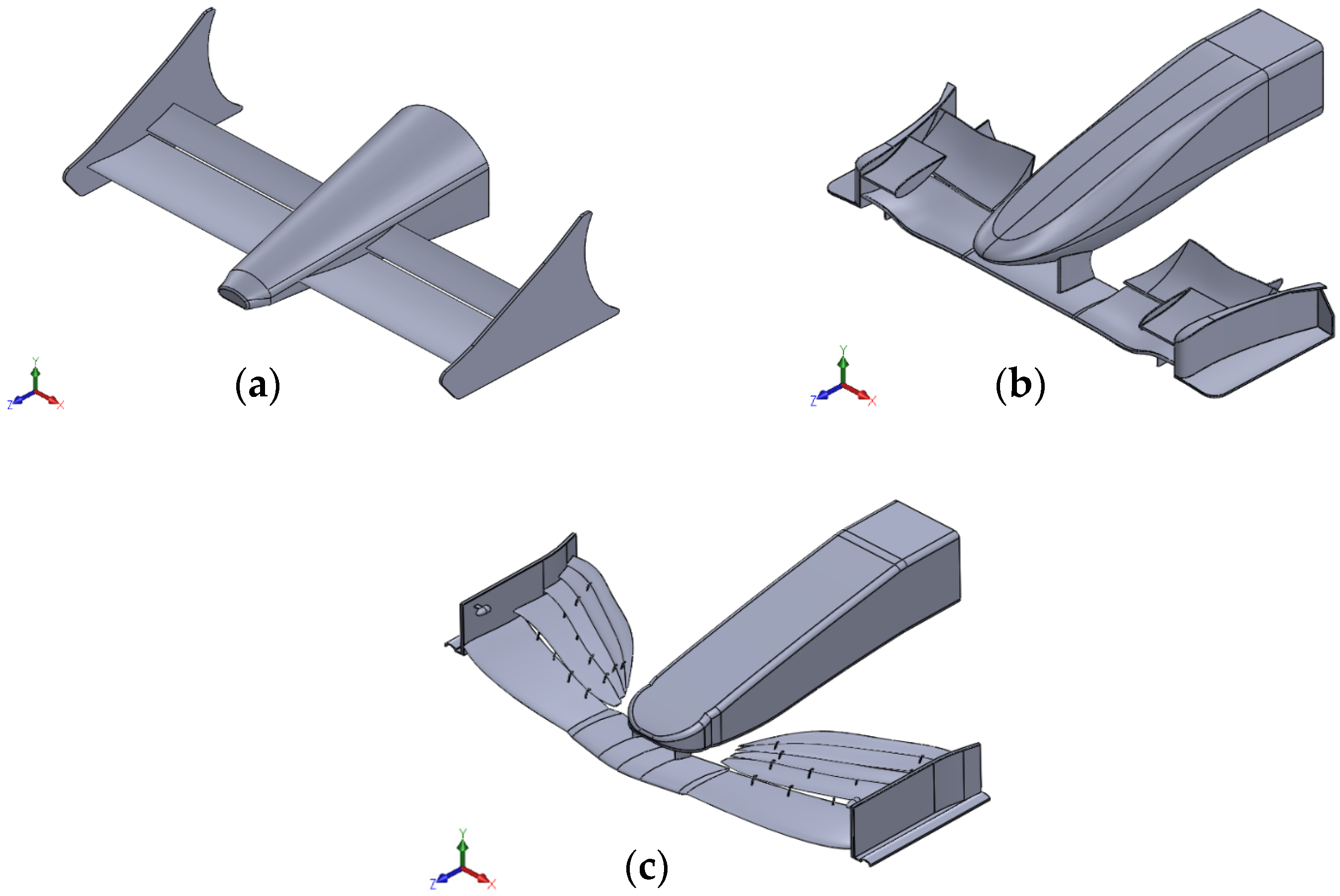
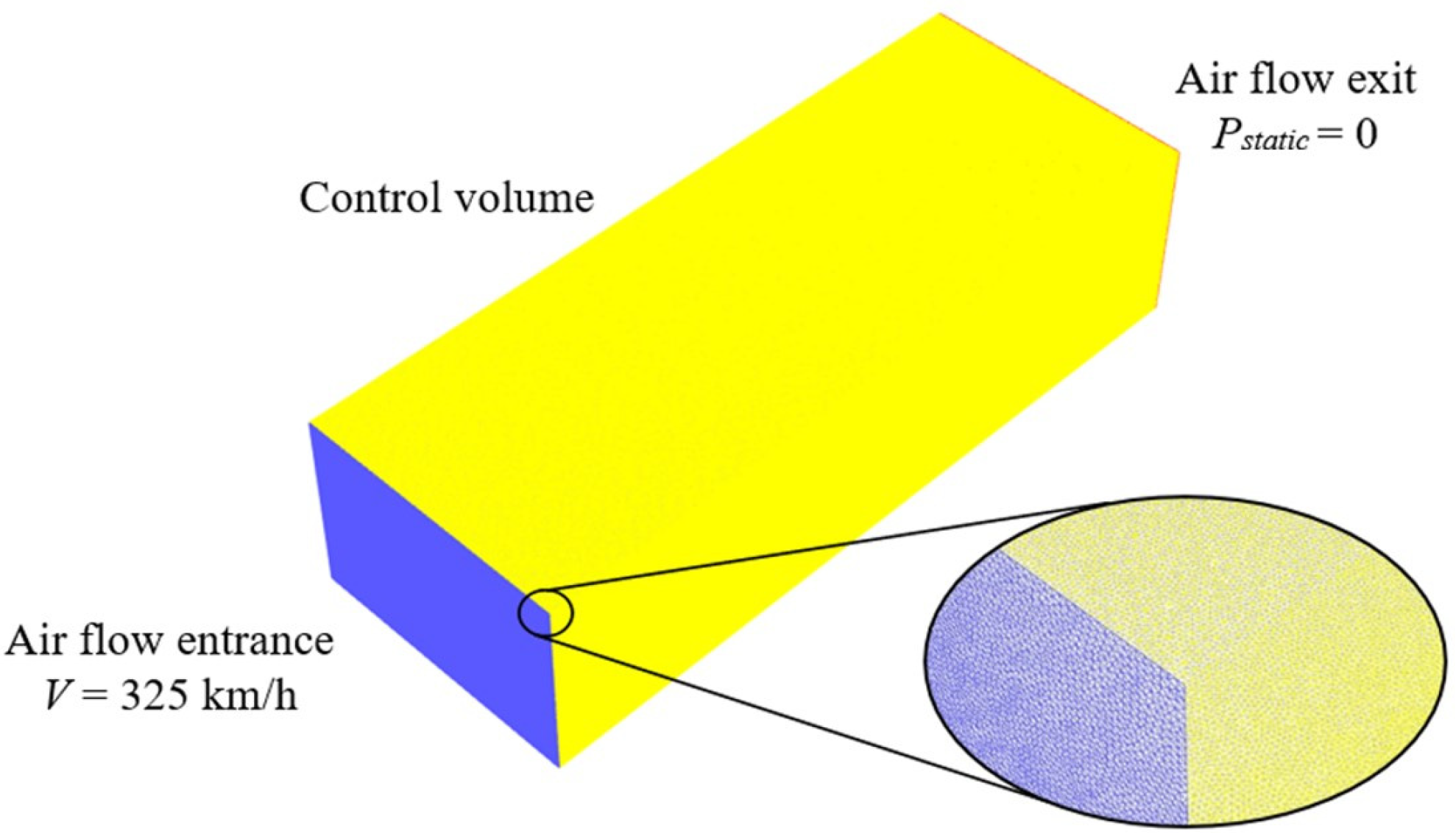
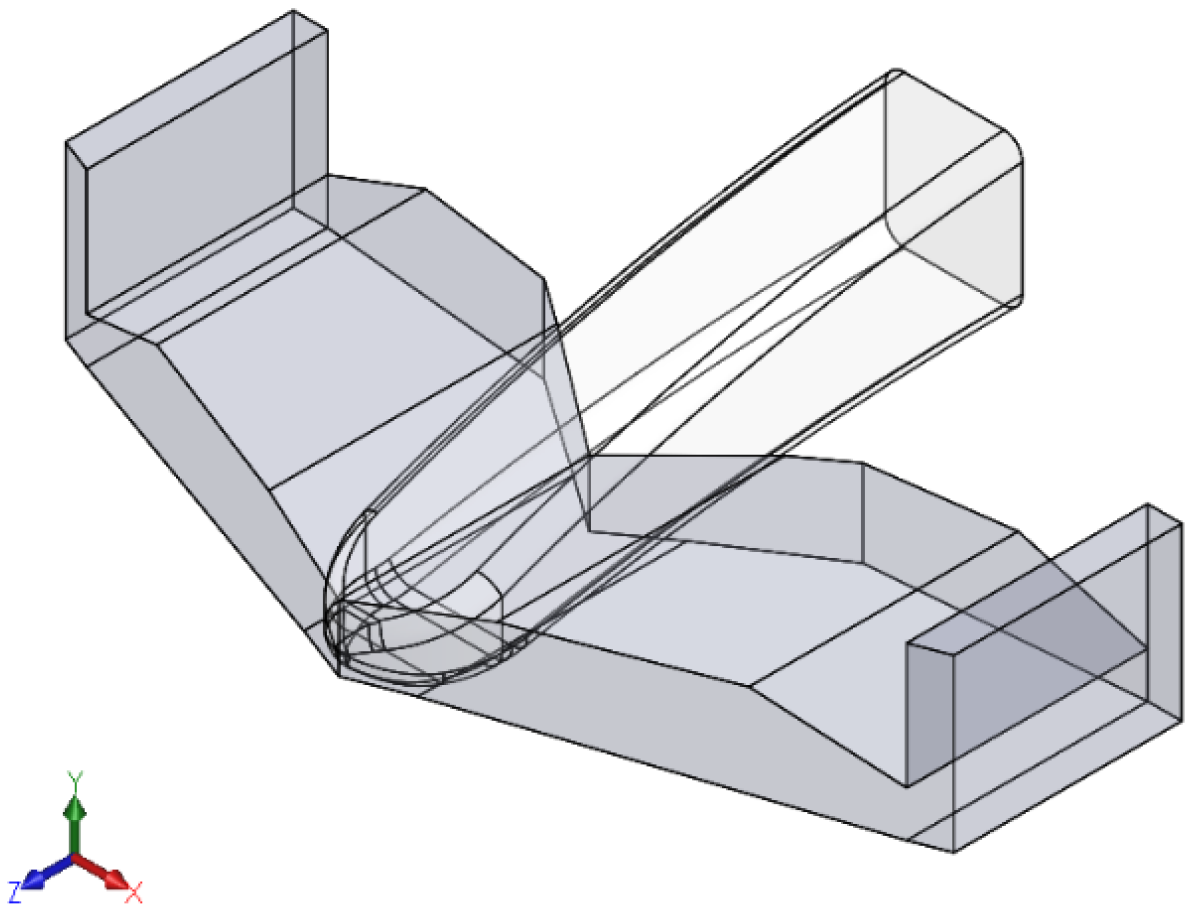


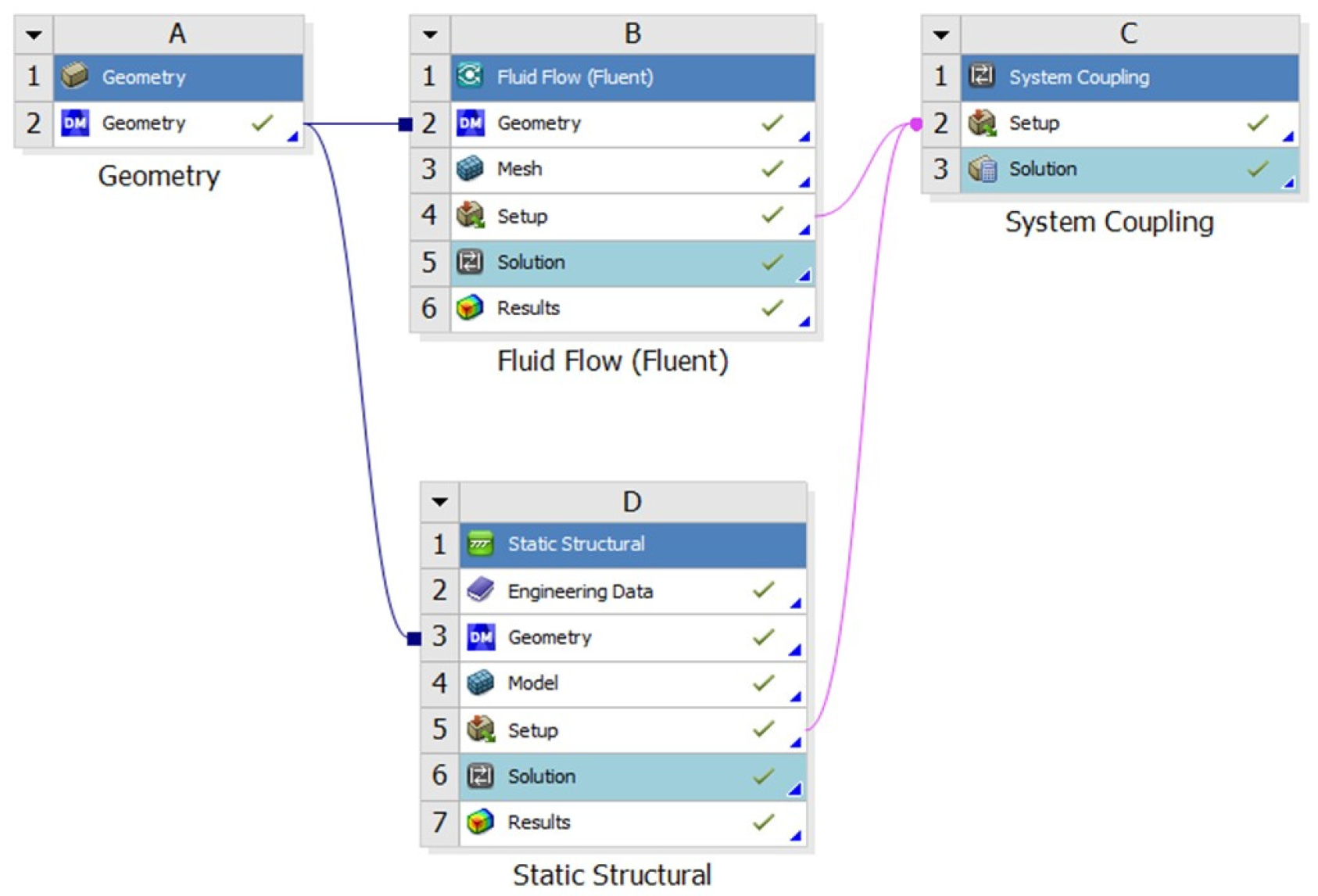
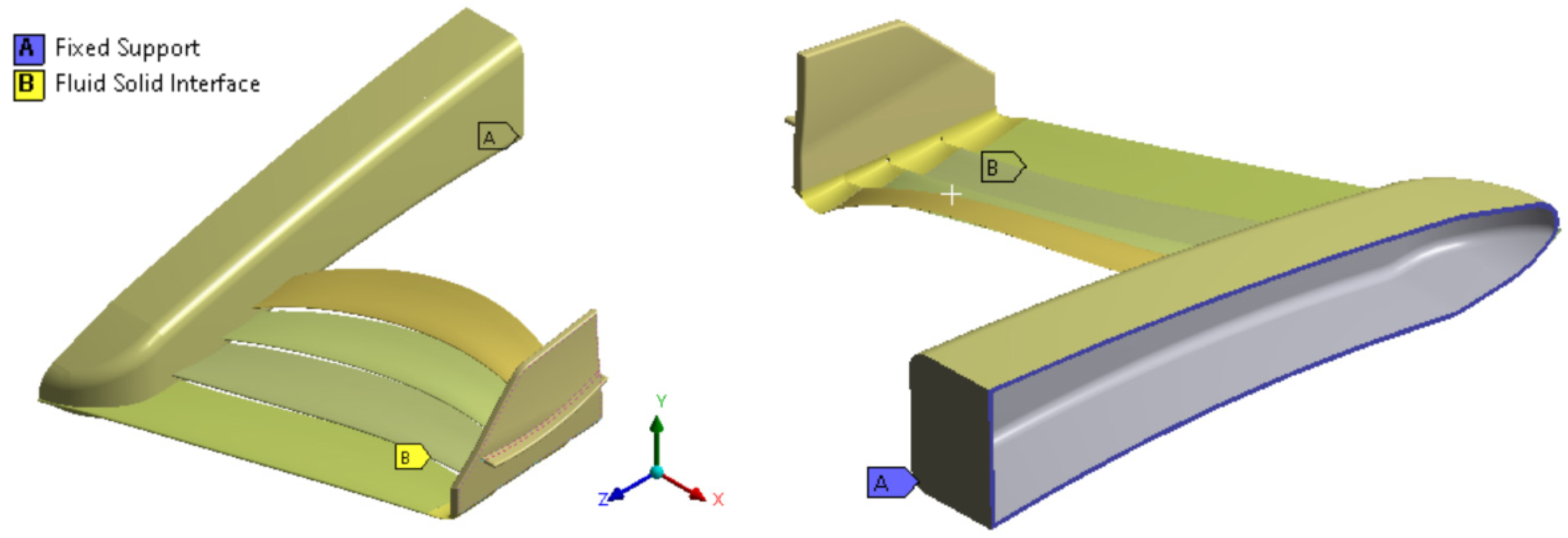
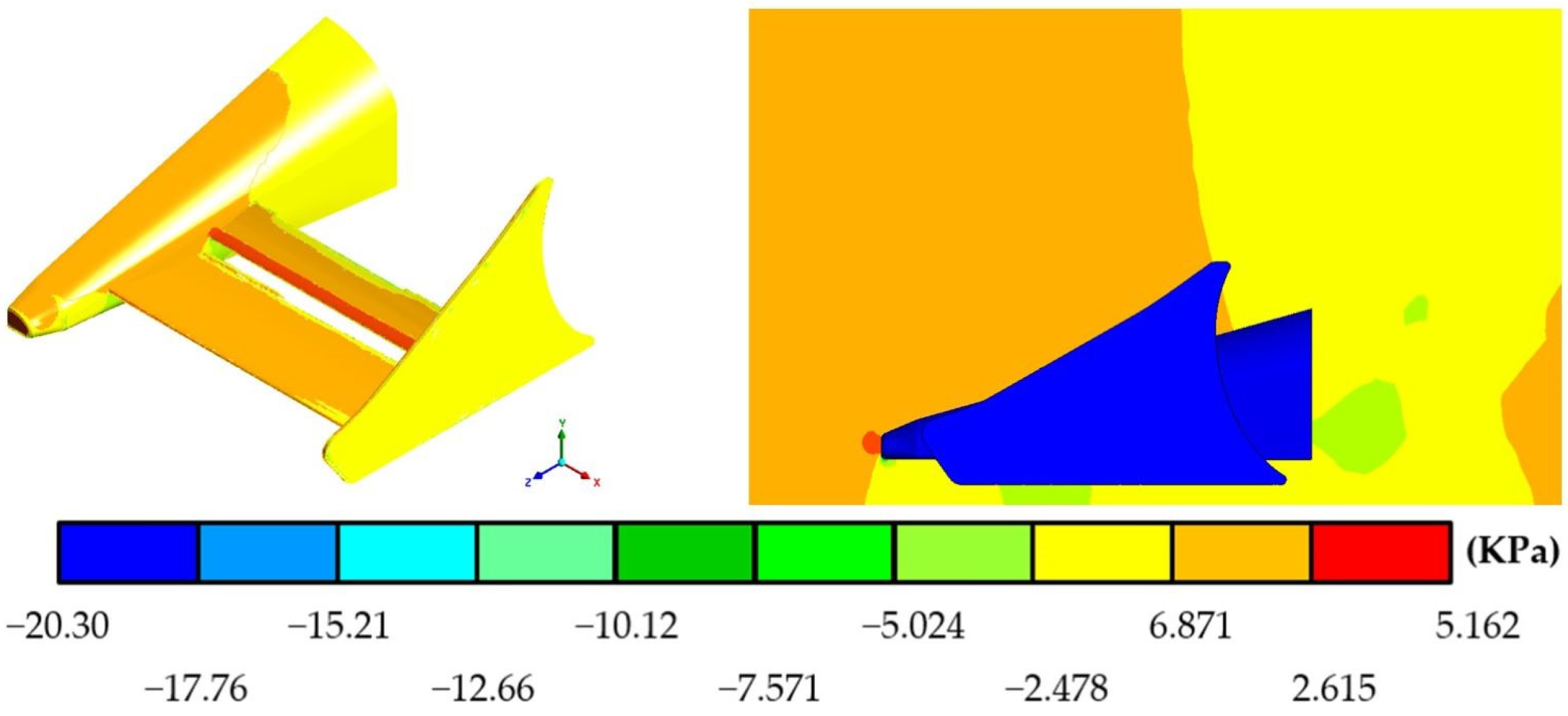
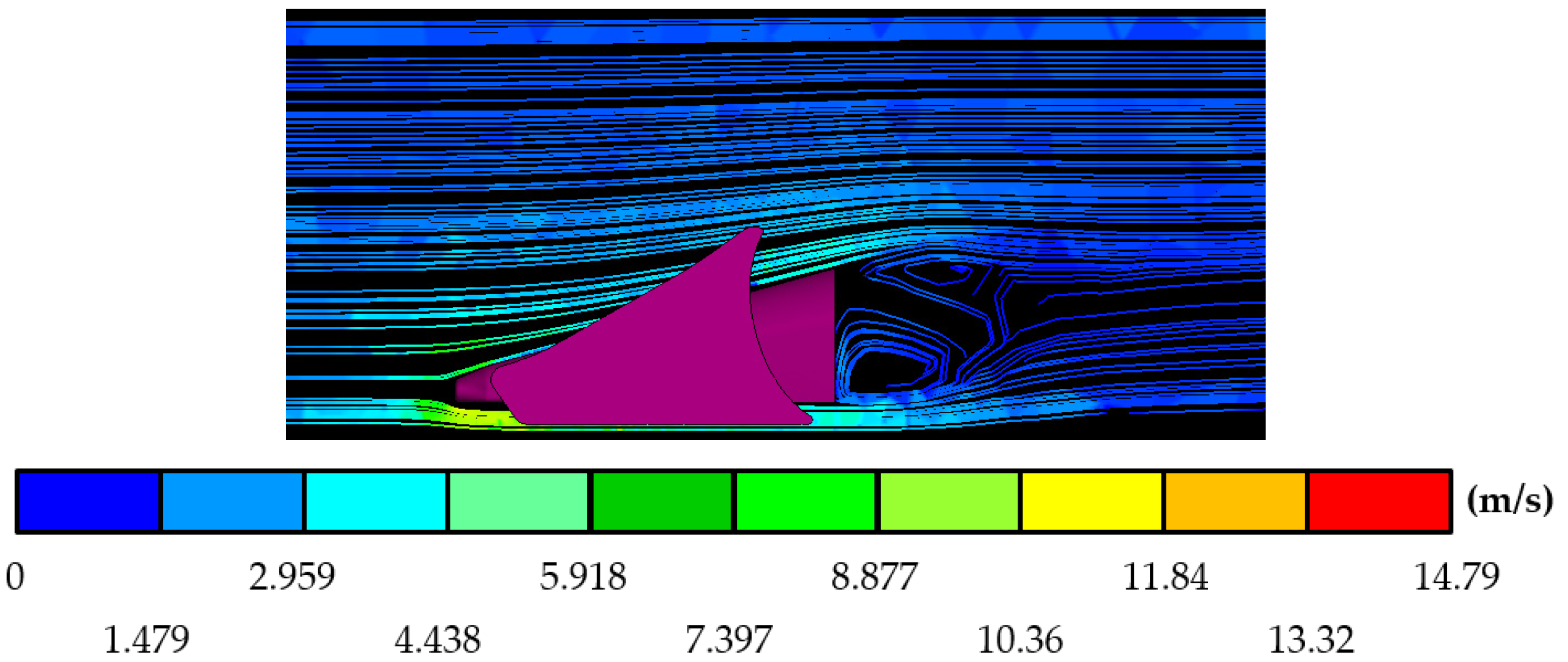
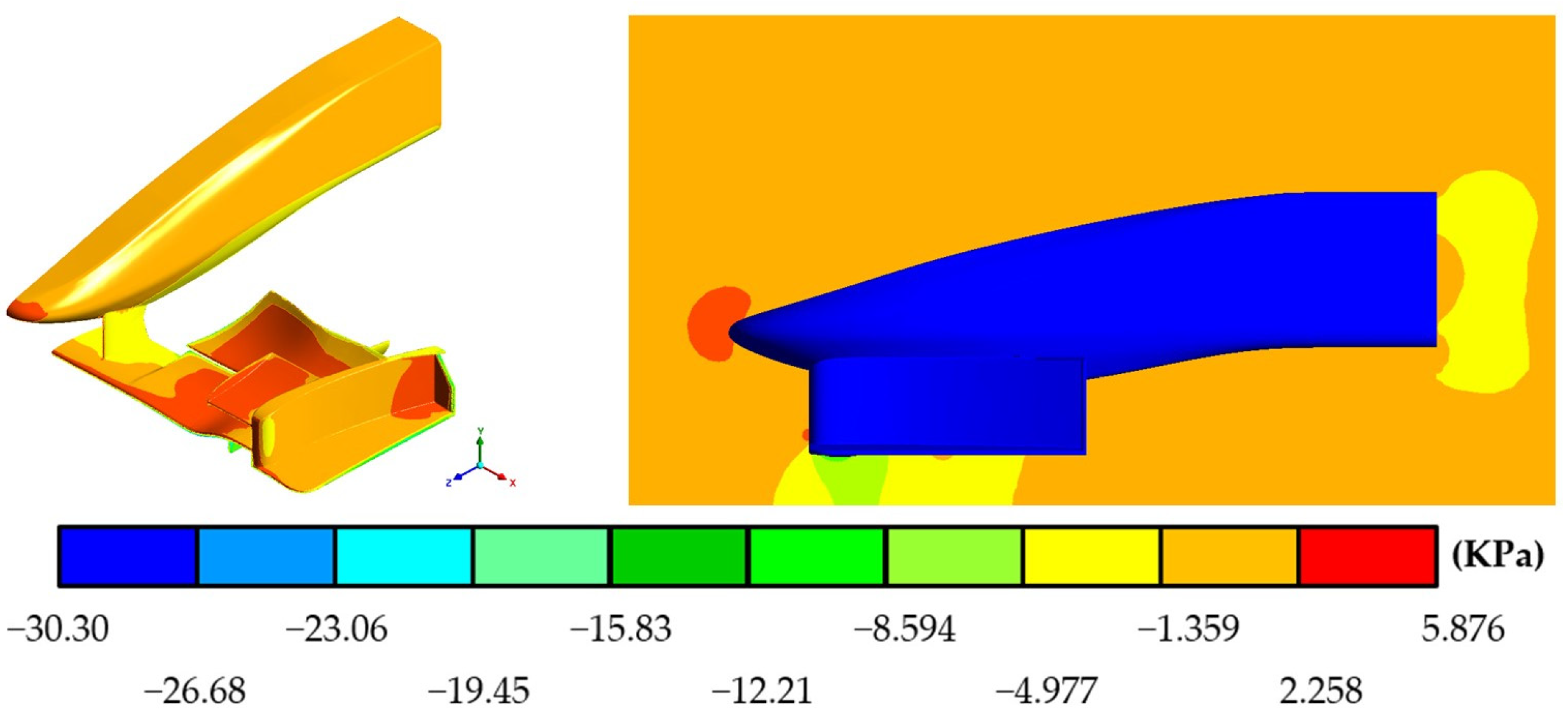
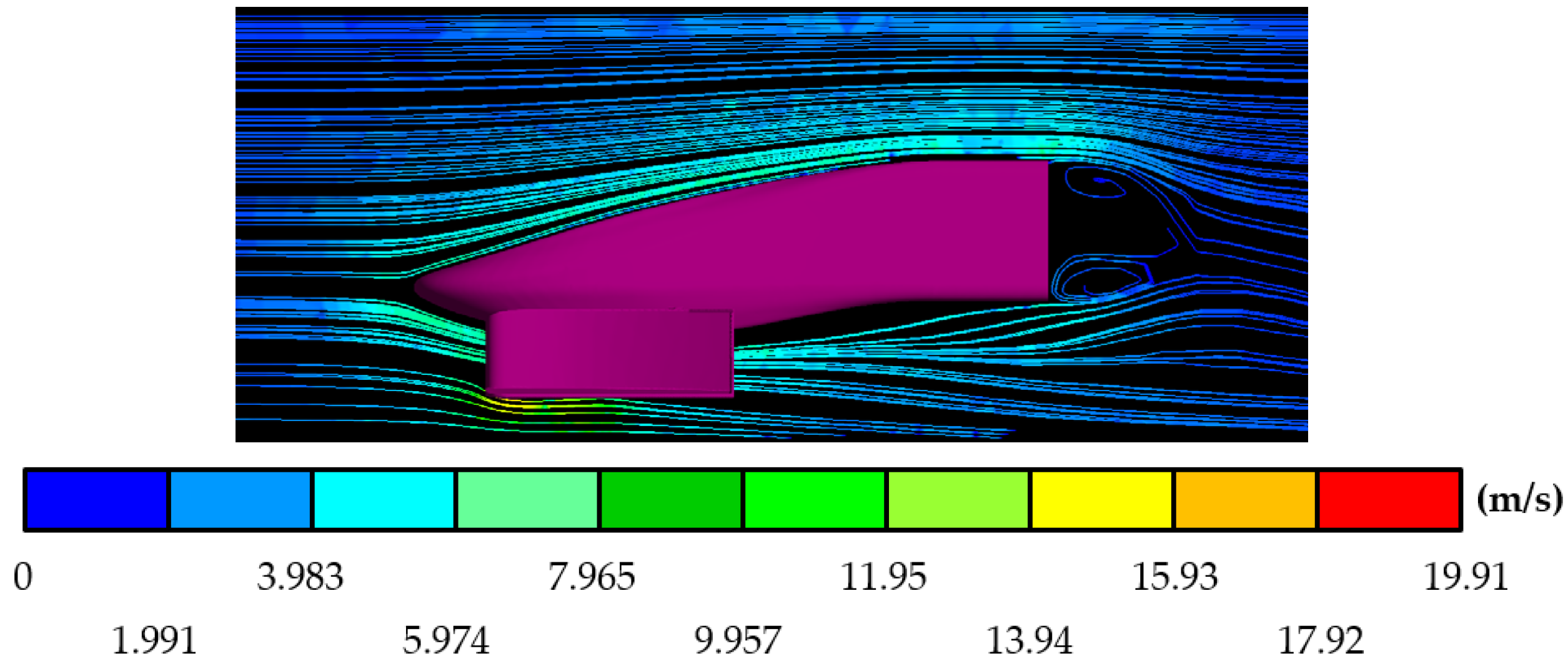
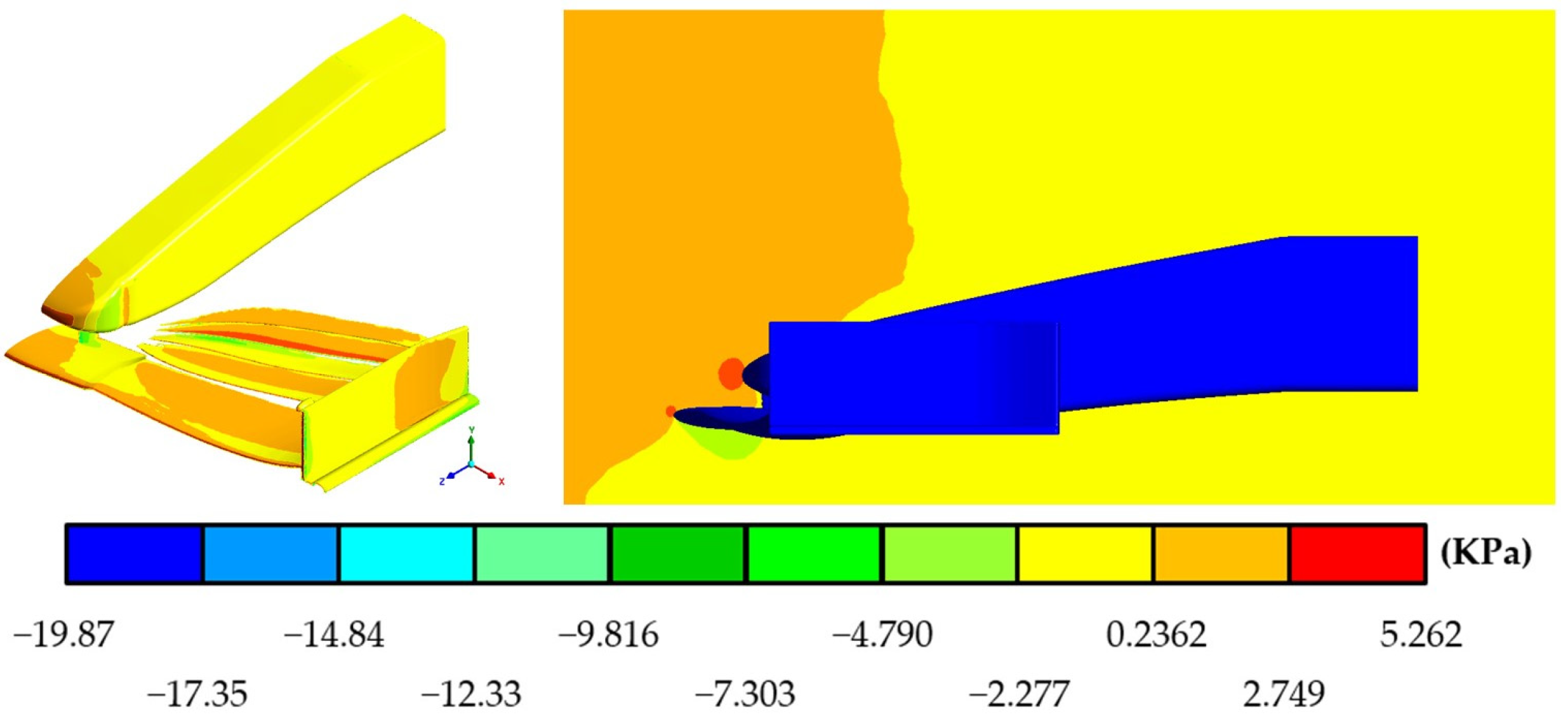
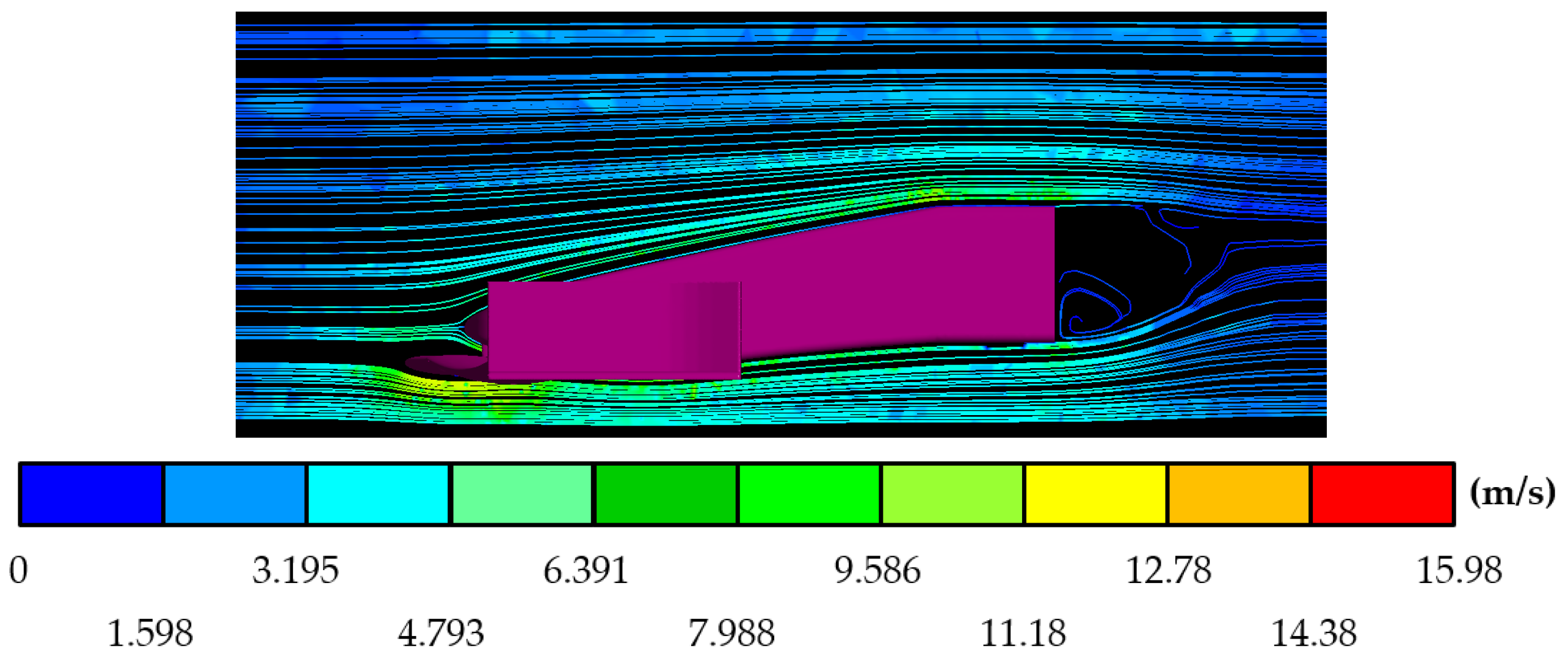
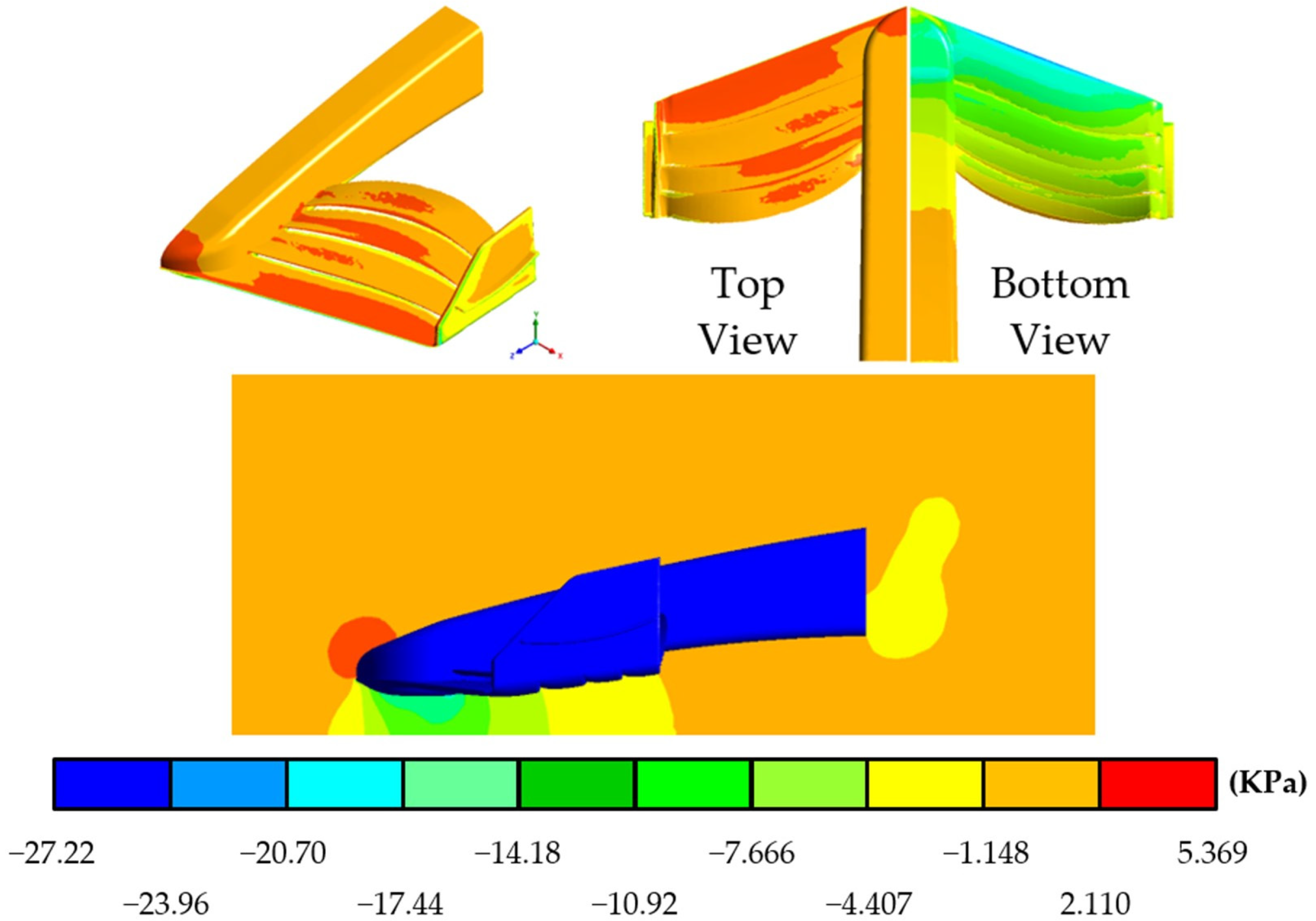
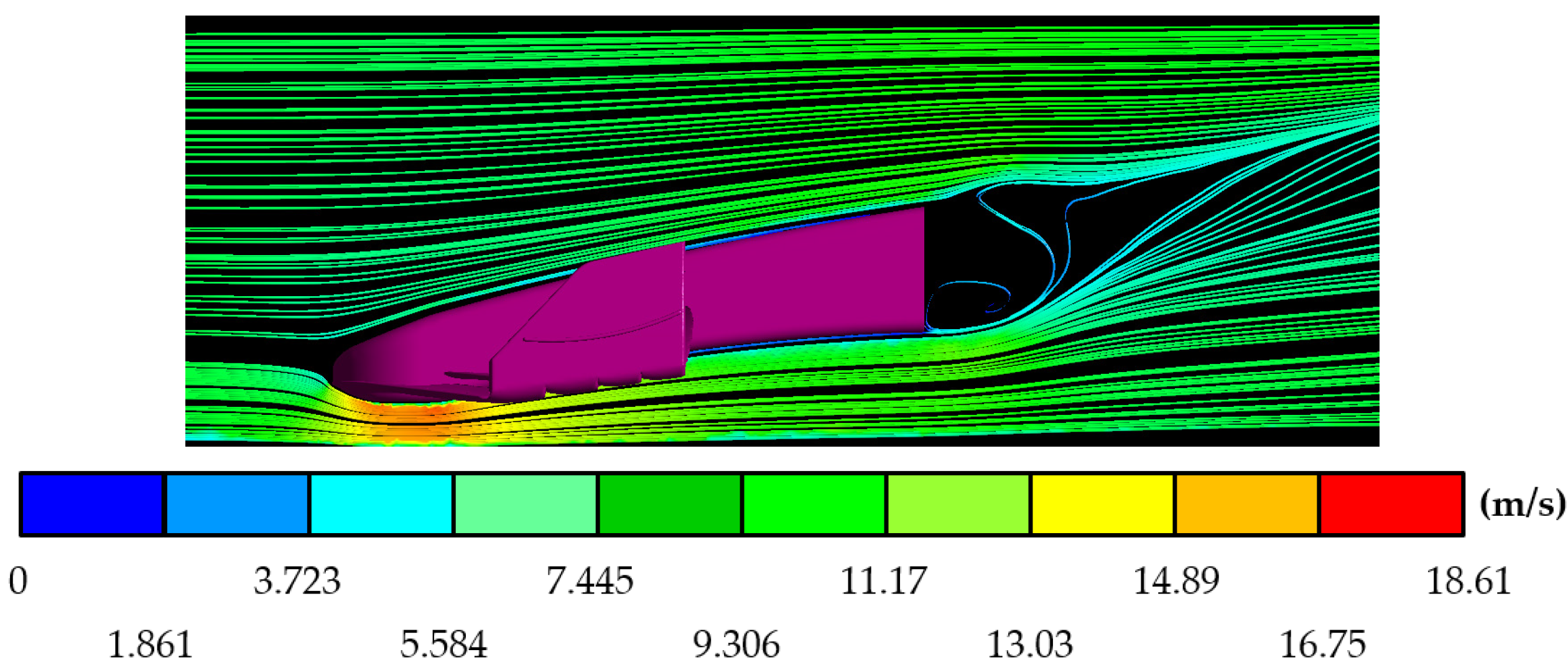

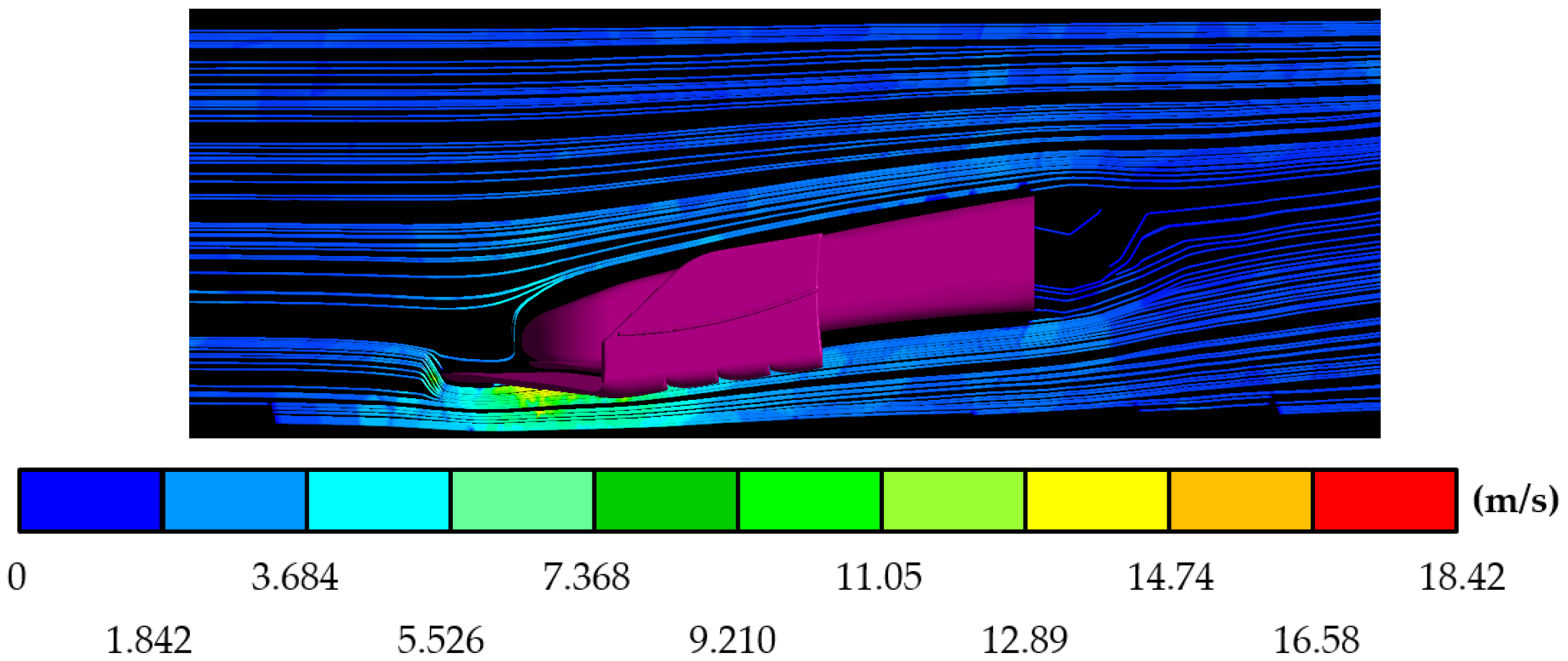


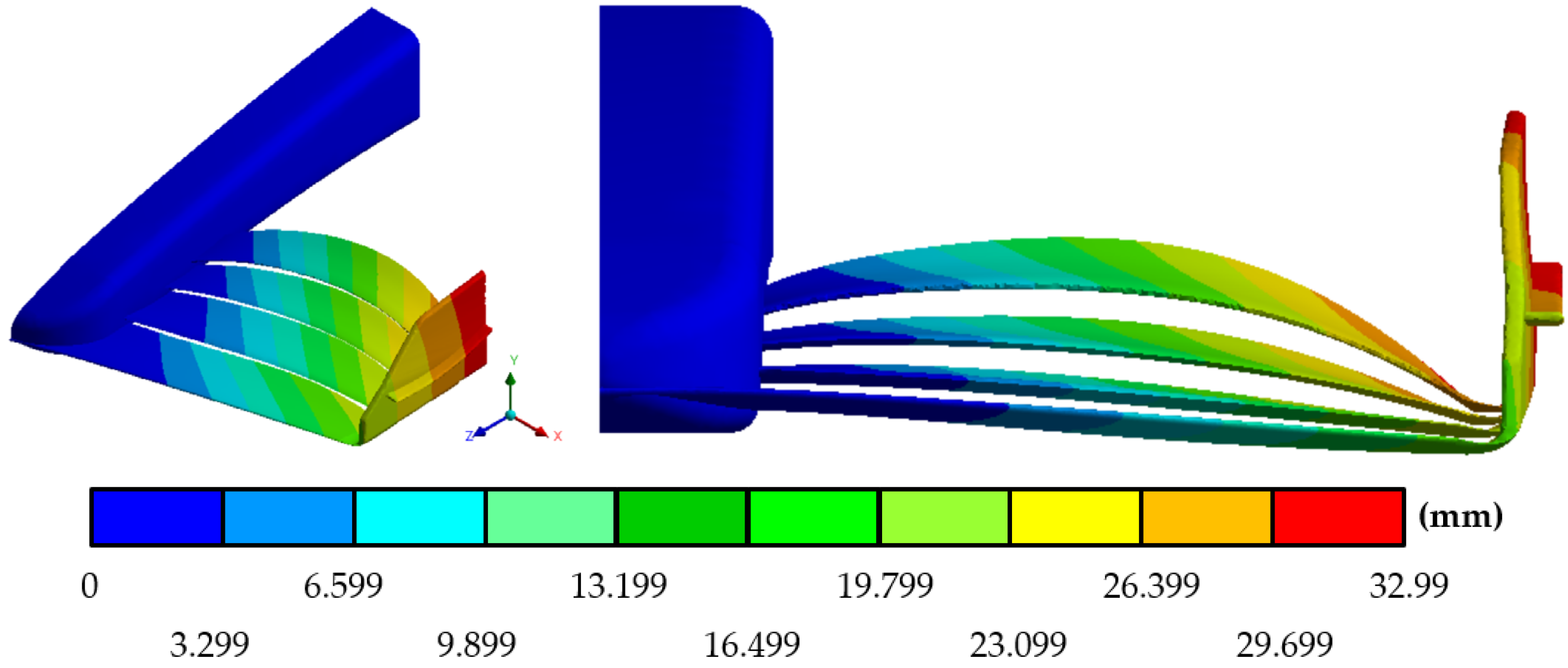
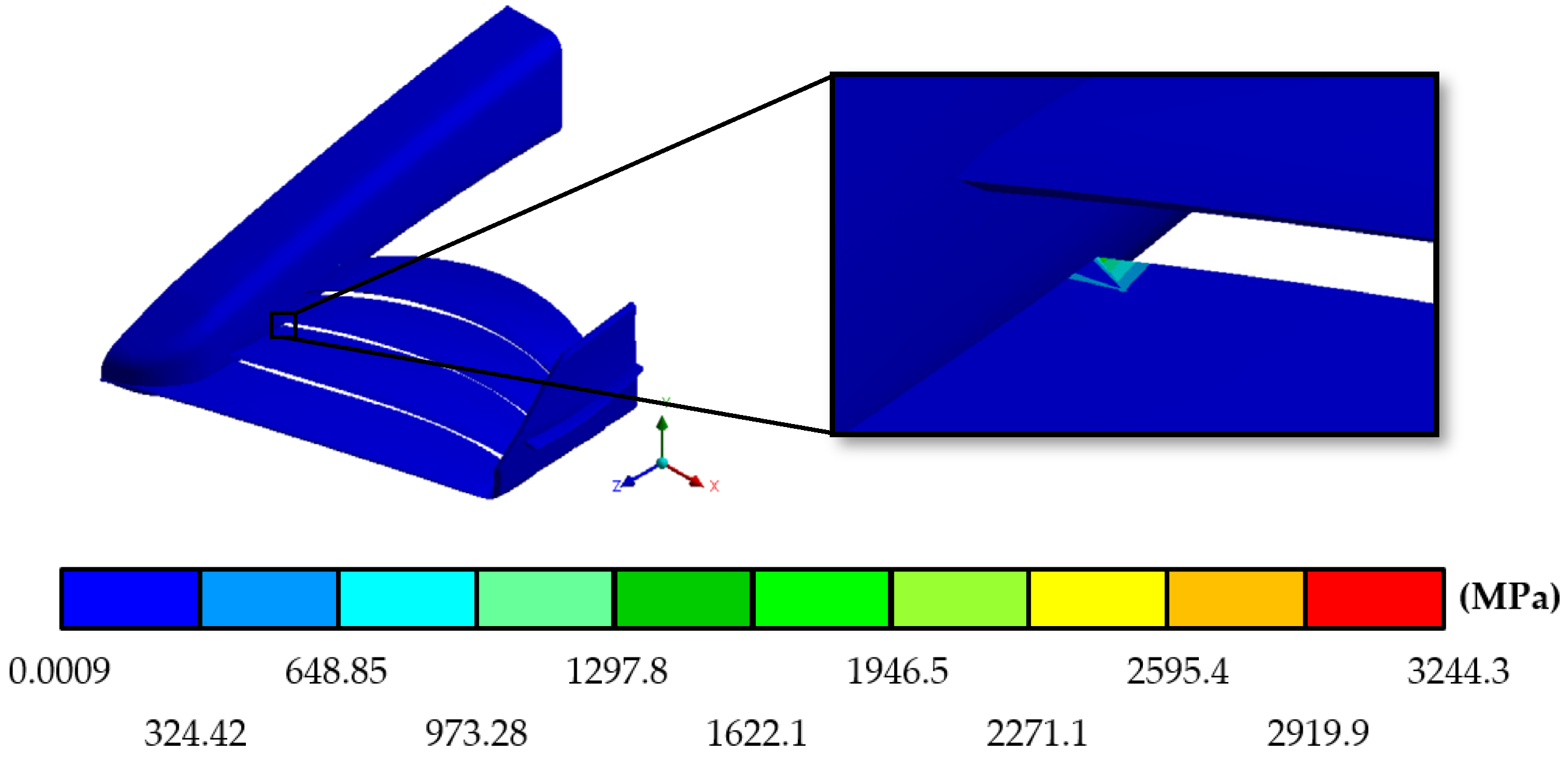
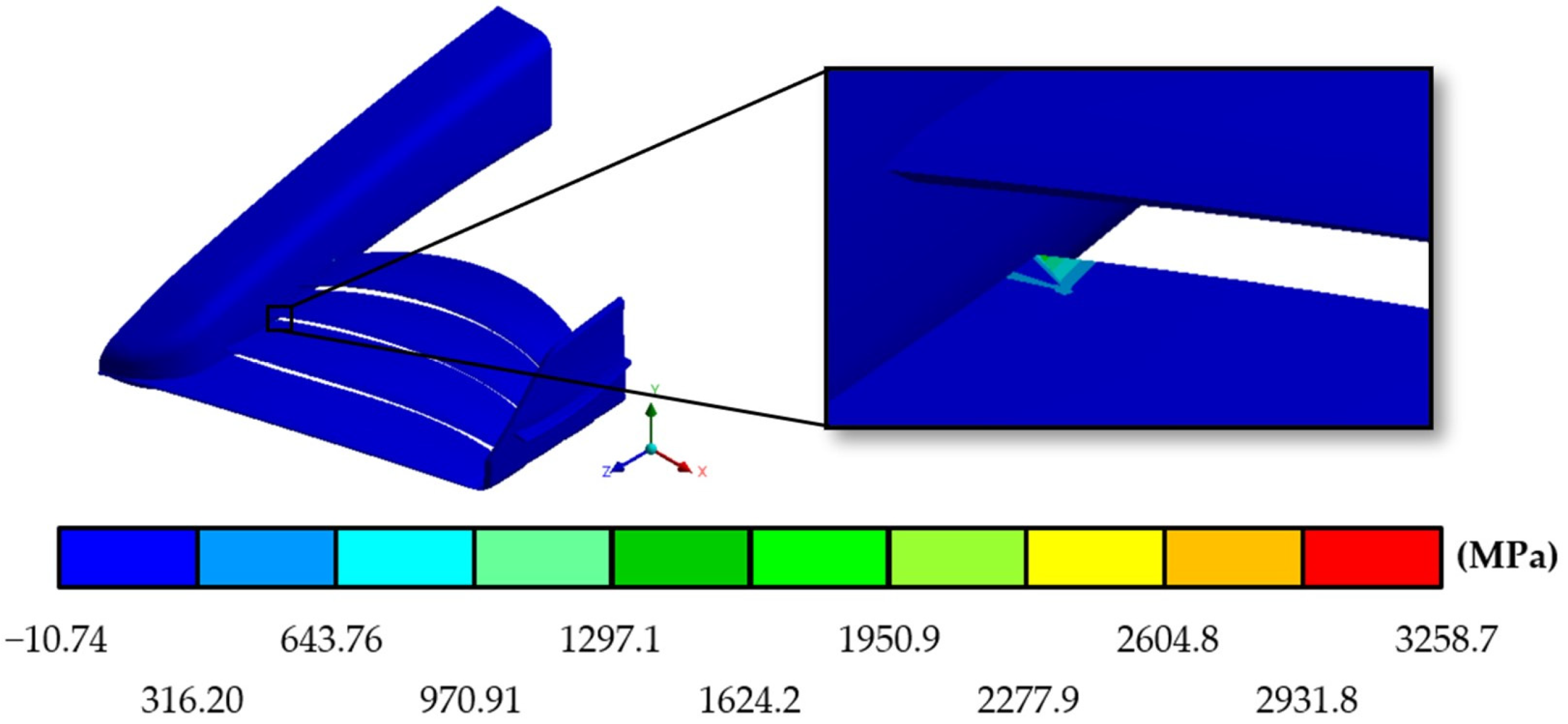

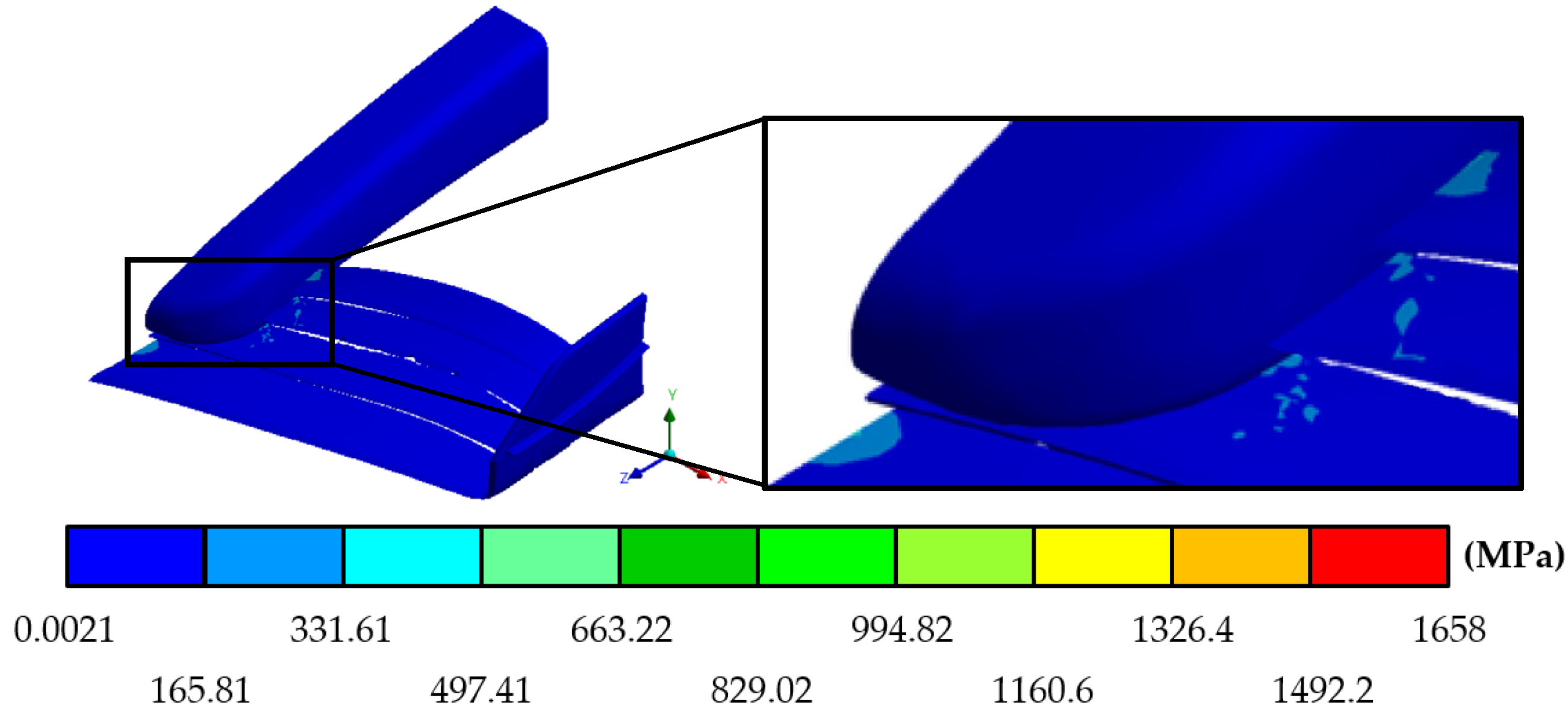
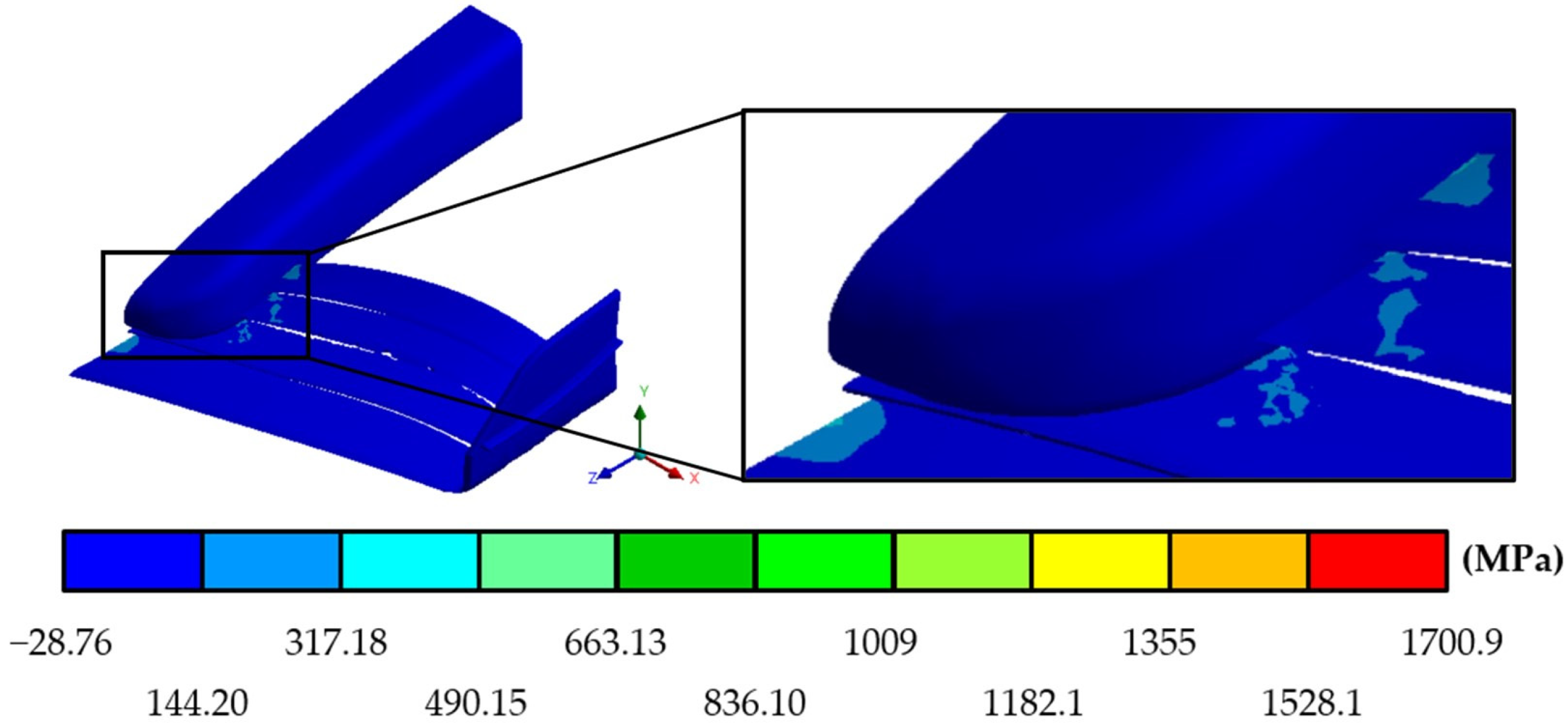
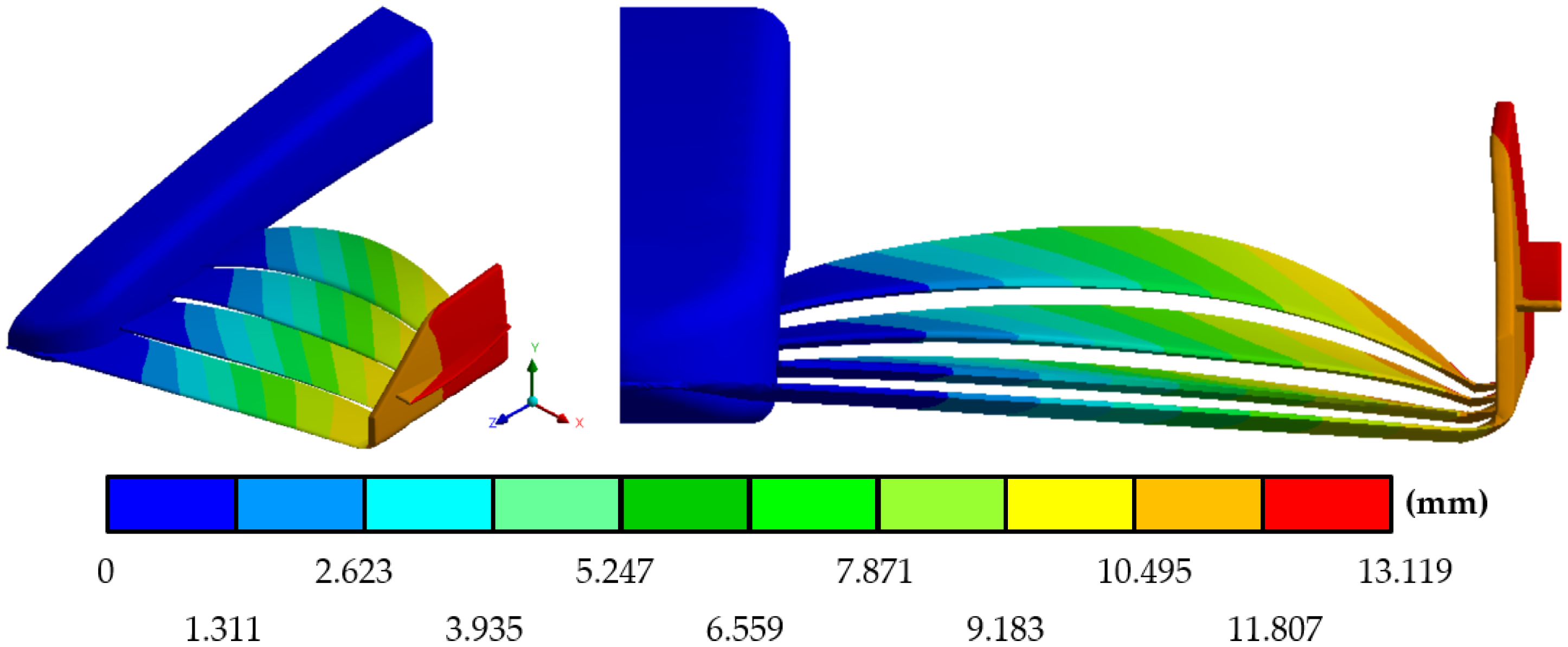
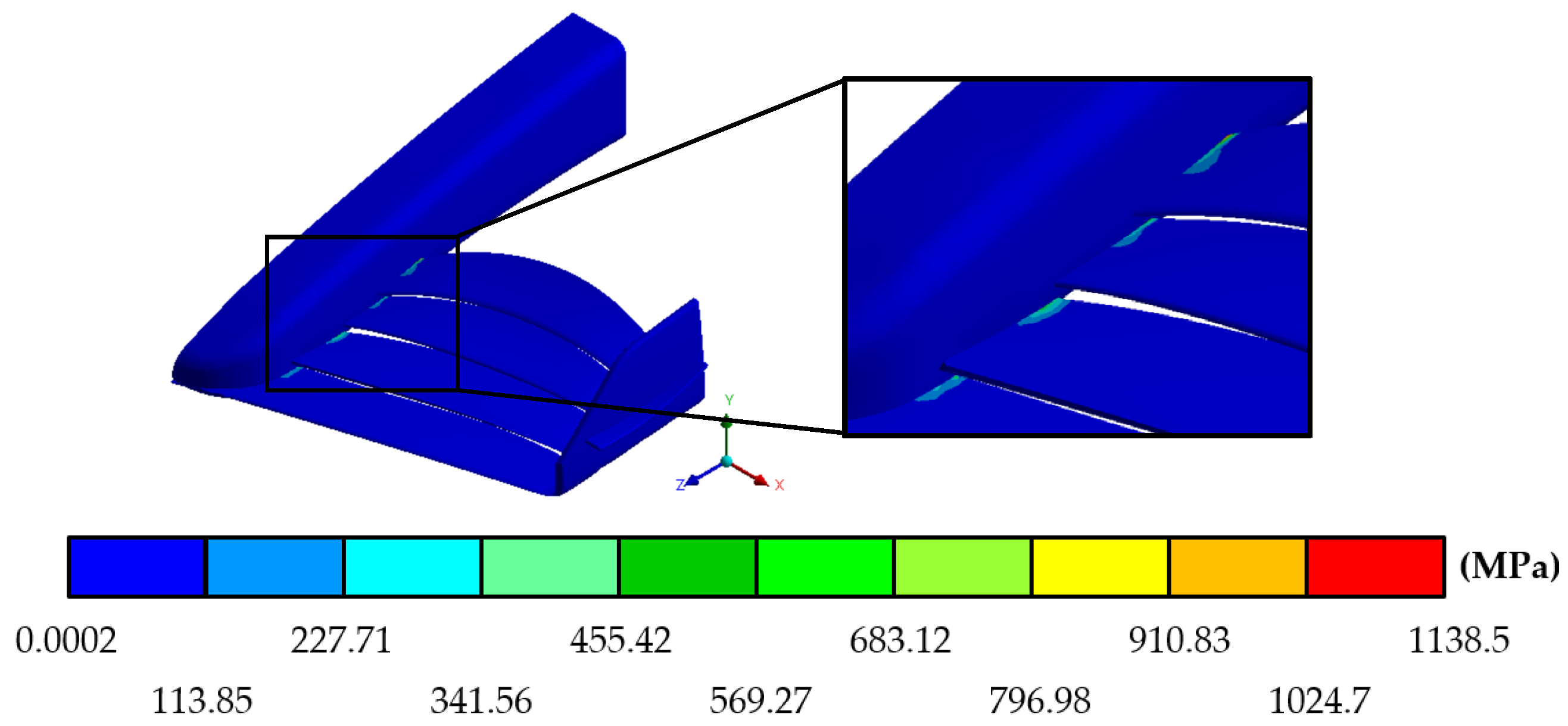
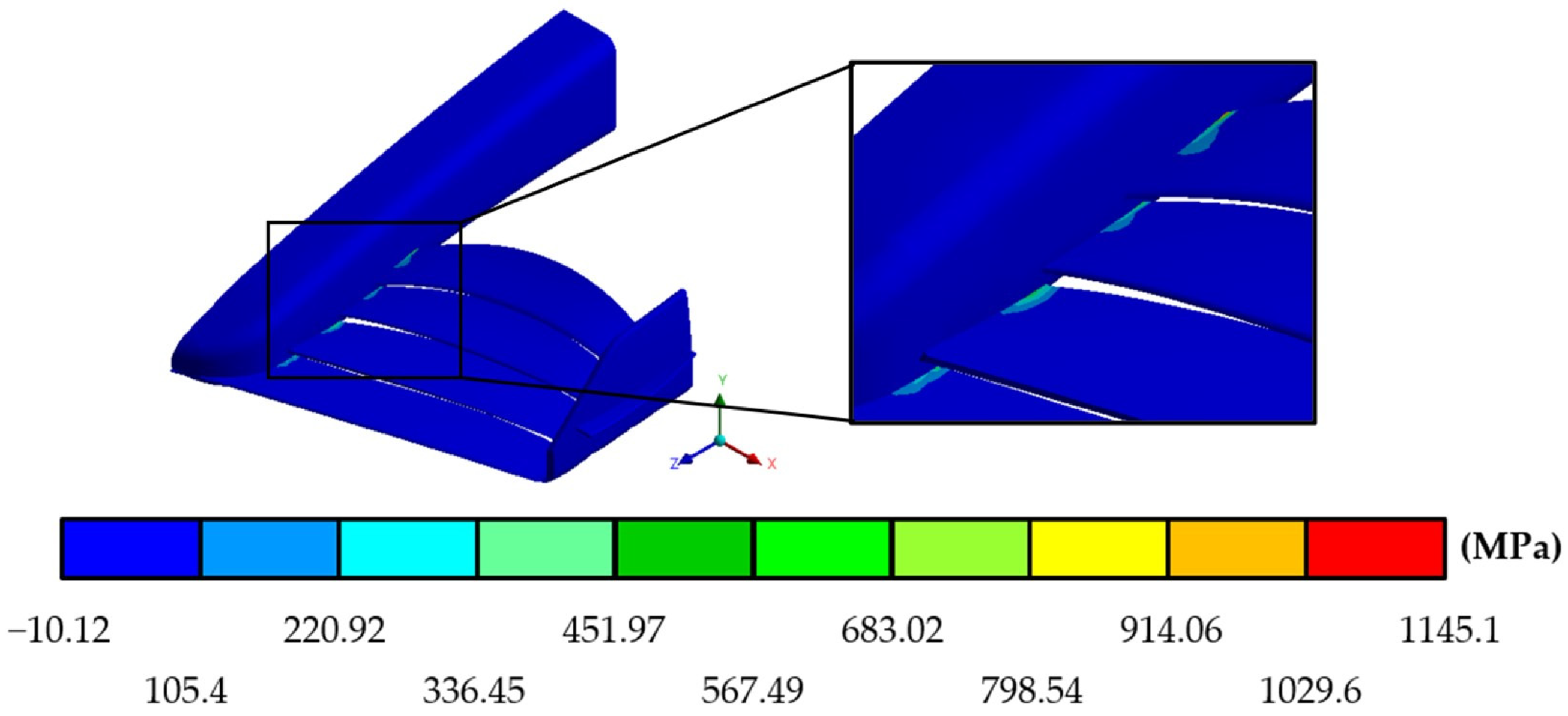



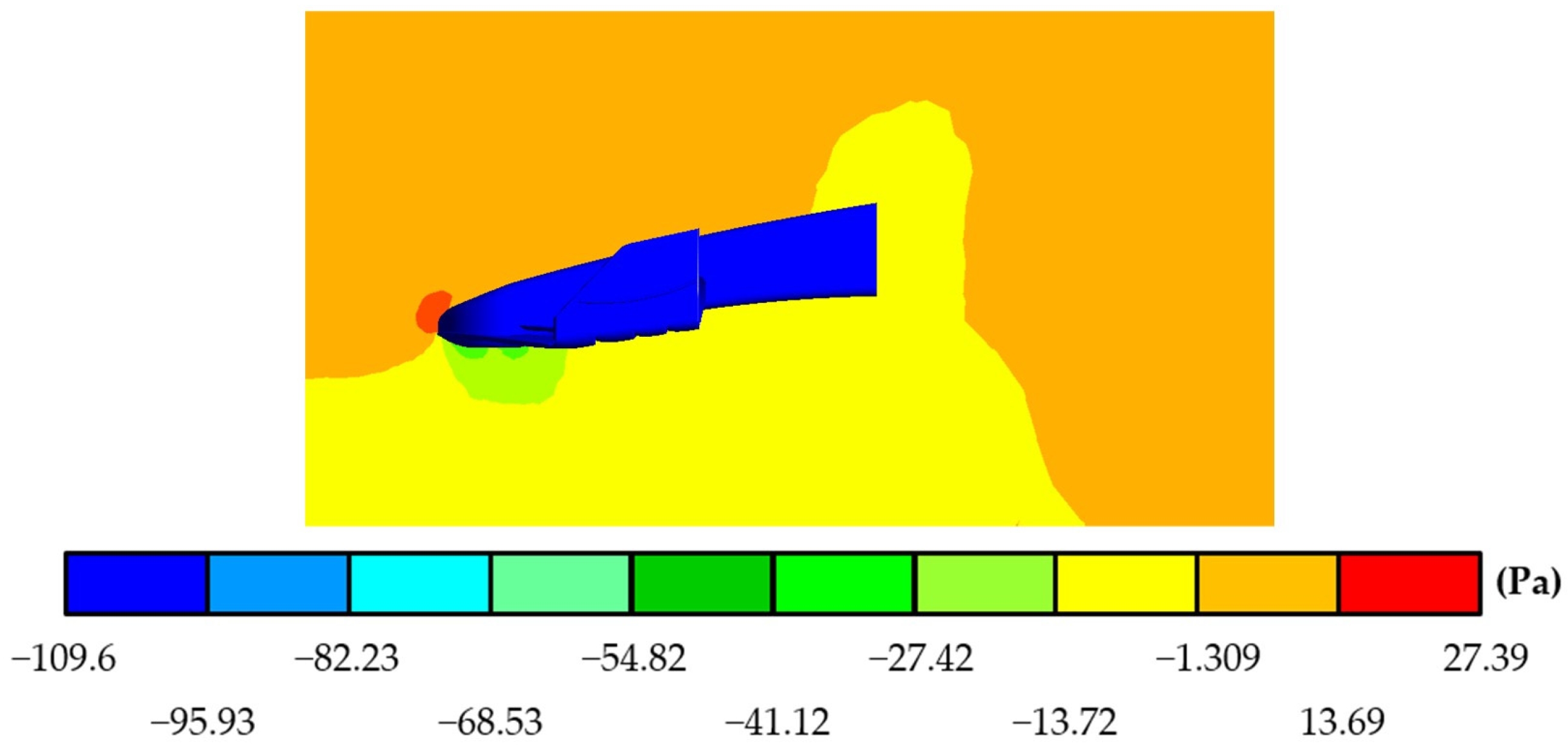
| Parameter | Value | Units |
|---|---|---|
| Atmospheric pressure | 101.325 | KPa |
| Density | 1.225 | kg/m3 |
| Temperature | 288.15 | K |
| Dynamic Viscosity | 1.8 × 10−5 | Pa∙s |
| Parameter | Article/Annexes |
|---|---|
| Bodywork | Art. 3.6.1, A-9, A-11 |
| Airfoils | Art. 3.9.1, A-24, A-26 |
| Endplate | Art. 3.9.2, Art. 3.9.5, A-23 |
| Diveplane | Art. 3.9.6, A-22, A-25 |
| Assembly | Art. 3.9.6, Art. 3.9.9, Art. 3.11.4, A-21 |
| Front wing tip | Art. 3.9.3 |
| Coordinate systems and reference volumes | Art. 2.10, Art. 2.11 |
| Materials | Art. 15.3 |
| Parameter | Value | Units |
|---|---|---|
| Density | 1.83 | g/cm3 |
| Elastic limit | 4826 | MPa |
| Breaking point | 435 | GPa |
| Poisson’s ratio | 0.2 | - |
| Filament diameter | 4.9 | microns |
| Thermal conductivity | 55 | W/m·K |
| Carbon content | 99 | % |
| Front Wing | Max. Downforce (N) | Max. Drag (N) | Drag–Downforce Relationship (%) | CL | CD |
|---|---|---|---|---|---|
| McLaren MP4/4 | 1516.59 | 248.585 | 16.391 | −1.608 | 0.2636 |
| Williams FW31 | 4221.29 | 1022.1 | 24.212 | −2.347 | 0.5683 |
| Mercedes-AMG W12 (based) | 2022.88 | 319.104 | 15.774 | −1.329 | 0.2097 |
| Front Wing | Max. Downforce (N) | Max. Drag (N) | Drag–Downforce Relationship (%) | CL | CD |
|---|---|---|---|---|---|
| MICC-75 | 5782.28 | 499.401 | 8.636 | −3.131 | 0.2704 |
| CLV-545 | 5217.07 | 669.72 | 12.837 | −2.766 | 0.3550 |
| JJRC-10 | 6035.78 | 528.149 | 8.750 | −3.096 | 0.2709 |
| Front Wing | |||||
|---|---|---|---|---|---|
| MICC-75 | CLV-54 | JJRC-10 | |||
| Total displacement (mm) | |||||
| 32.99 | 31.197 | 13.119 | |||
| Nominal displacements in the X axis (mm) | |||||
| Max. | Min. | Max. | Min. | Max. | Min. |
| 2.6523 | −3.6944 | 3.6504 | −3.3862 | 2.8364 | −1.5841 |
| Nominal displacements in the Y axis (mm) | |||||
| Max. | Min. | Max. | Min. | Max. | Min. |
| 0.07876 | −31.753 | 0.01503 | −29.111 | 0.4199 | −13.035 |
| Nominal displacements in the Z axis (mm) | |||||
| Max. | Min. | Max. | Min. | Max. | Min. |
| 0.20715 | −10.62 | 0.17867 | −11.397 | 0.3915 | −2.1475 |
| Total unit strain (mm/mm) | |||||
| 0.02269 | 0.0288 | 0.01244 | |||
| Maximum Von Mises stress (MPa) | |||||
| 3244.3 | 1658 | 1138.5 | |||
| Nominal stress in X axis (MPa) | |||||
| Max. | Min. | Max. | Min. | Max. | Min. |
| 3248.7 | −1534.5 | 1677.7 | −941.84 | 1144.8 | −592.17 |
| Nominal stress in Y axis (MPa) | |||||
| Max. | Min. | Max. | Min. | Max. | Min. |
| 78.039 | −27.206 | 62.783 | −53.221 | 27.778 | −24.627 |
| Nominal stress in the Z axis (MPa) | |||||
| Max. | Min. | Max. | Min. | Max. | Min. |
| 39.624 | −39.891 | 47.628 | −75.565 | 17.98 | −10.713 |
| Shear forces in the XY plane (MPa) | |||||
| Max. | Min. | Max. | Min. | Max. | Min. |
| 103.22 | −168.74 | 62.602 | −74.708 | 36.987 | −82.895 |
| Shear forces in the YZ plane (MPa) | |||||
| Max. | Min. | Max. | Min. | Max. | Min. |
| 19.551 | −35.313 | 17.103 | −33.822 | 16.783 | −6.8902 |
| Shear forces in the XZ plane (MPa) | |||||
| Max. | Min. | Max. | Min. | Max. | Min. |
| 96.97 | −180.24 | 180.34 | −49.409 | 46.413 | −14.114 |
| Maximum principal stress (MPa) | |||||
| Max. | Min. | Max. | Min. | Max. | Min. |
| 3258.7 | −10.74 | 1700.9 | −28.769 | 1145.1 | −10.124 |
| Minimum principal stress (MPa) | |||||
| Max. | Min. | Max. | Min. | Max. | Min. |
| 18.381 | −1537.3 | 17.644 | −945.92 | 5.978 | −597.74 |
| Test | Downforce (N) | Drag (N) | Airflow Speed (km/h) | CL | CD |
|---|---|---|---|---|---|
| 1 | 5.6 | 0.6 | 46.55 | −0.5279 | 0.0650 |
| 2 | 9.9 | 1.2 | 61.58 | −0.5332 | 0.0646 |
| 3 | 15.1 | 1.7 | 75.06 | −0.5474 | 0.0616 |
| Test | Airflow Speed (km/h) | Downforce (N) | Drag (N) | ||
|---|---|---|---|---|---|
| Experimental | Simulation | Experimental | Simulation | ||
| 1 | 46.55 | 5.6 | 5.6395 | 0.6 | 0.7180 |
| 2 | 61.58 | 9.9 | 9.9341 | 1.2 | 1.2771 |
| 3 | 75.06 | 15.1 | 14.7767 | 1.8 | 1.8765 |
Disclaimer/Publisher’s Note: The statements, opinions and data contained in all publications are solely those of the individual author(s) and contributor(s) and not of MDPI and/or the editor(s). MDPI and/or the editor(s) disclaim responsibility for any injury to people or property resulting from any ideas, methods, instructions or products referred to in the content. |
© 2023 by the authors. Licensee MDPI, Basel, Switzerland. This article is an open access article distributed under the terms and conditions of the Creative Commons Attribution (CC BY) license (https://creativecommons.org/licenses/by/4.0/).
Share and Cite
Laguna-Canales, A.S.; Urriolagoitia-Sosa, G.; Romero-Ángeles, B.; Martinez-Mondragon, M.; García-Laguna, M.A.; Correa-Corona, M.I.; Maya-Anaya, D.; Urriolagoitia-Calderón, G.M. Mechanical Design and Numerical Analysis of a New Front Wing for a Formula One Vehicle. Fluids 2023, 8, 210. https://doi.org/10.3390/fluids8070210
Laguna-Canales AS, Urriolagoitia-Sosa G, Romero-Ángeles B, Martinez-Mondragon M, García-Laguna MA, Correa-Corona MI, Maya-Anaya D, Urriolagoitia-Calderón GM. Mechanical Design and Numerical Analysis of a New Front Wing for a Formula One Vehicle. Fluids. 2023; 8(7):210. https://doi.org/10.3390/fluids8070210
Chicago/Turabian StyleLaguna-Canales, Aldo Saul, Guillermo Urriolagoitia-Sosa, Beatriz Romero-Ángeles, Miguel Martinez-Mondragon, Miguel Angel García-Laguna, Martin Ivan Correa-Corona, Daniel Maya-Anaya, and Guillermo Manuel Urriolagoitia-Calderón. 2023. "Mechanical Design and Numerical Analysis of a New Front Wing for a Formula One Vehicle" Fluids 8, no. 7: 210. https://doi.org/10.3390/fluids8070210
APA StyleLaguna-Canales, A. S., Urriolagoitia-Sosa, G., Romero-Ángeles, B., Martinez-Mondragon, M., García-Laguna, M. A., Correa-Corona, M. I., Maya-Anaya, D., & Urriolagoitia-Calderón, G. M. (2023). Mechanical Design and Numerical Analysis of a New Front Wing for a Formula One Vehicle. Fluids, 8(7), 210. https://doi.org/10.3390/fluids8070210







